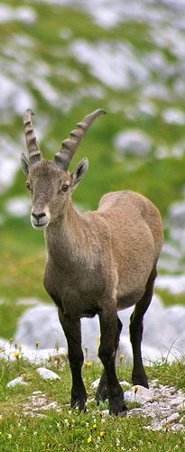 The Alpine Ibex (Capra ibex) is a stocky member of the goat family that lives in mountainous areas of Europe, mainly in the Swiss Alps. The male ibex has magnificent curved horns that can measure up to 1 meter long. The horns of the male have very distinct ridges along the whole length. The male ibex also has a thick beard and a heavy coat that changes color from gray in the summer to brown in the winter. The female ibex has smaller smooth horns, but lacks the beard. Her coat does not change color with the seasons and remains a light brown color year round.
The Alpine Ibex (Capra ibex) is a stocky member of the goat family that lives in mountainous areas of Europe, mainly in the Swiss Alps. The male ibex has magnificent curved horns that can measure up to 1 meter long. The horns of the male have very distinct ridges along the whole length. The male ibex also has a thick beard and a heavy coat that changes color from gray in the summer to brown in the winter. The female ibex has smaller smooth horns, but lacks the beard. Her coat does not change color with the seasons and remains a light brown color year round.The male and female Alpine ibex are excellent climbers and have adapted to life in a mountainous rocky terrain. They roam at lower altitudes in search of food during the morning and evening hours. They are herbivores and they subsist on a diet of grasses, hay, woody plants, and leaves. During the daylight hours, they remain at higher altitudes to avoid predators. Their predators include bears, wolves, foxes, golden eagles, and humans. In the wild, if they can avoid predators, Alpine ibexes have a lifespan of 10-14 years.
The Alpine ibexes live in groups, either in herds of females or bachelor groups of males. The males compete for the chance to join the herd of females during mating season.
The Alpine ibex was originally native to Italy but it almost became extinct in the early 19th century as a result of over-hunting. It was thought that the body parts of the ibex had magical powers. Conservation and re-introductions of the species in Switzerland, Austria, and France have increased their numbers and the ibex is not endangered at this time.
Picture of the Alpine ibex by Cash4alex, licensed under Attribution-Share Alike 3.0 Unported
Which zoos have them?
Brookfield Zoo (United States)The Alpine ibex, ibex is listed as Least Concern (LR/lc), lowest risk. Does not qualify for a more at risk category. Widespread and abundant taxa are included in this category, on the IUCN Red List of Threatened Species
Some facts about the
Ibex
Adult weight : 82.5 kg (181.5 lbs)
Maximum longevity : 21 years
Female maturity :797 days
Male maturity : 1256 days
Gestation : 169 days
Weaning : 274 days
Litter size : 1
Litters per year : 1
Interval between litters : 489 days
Weight at birth : 2.85 kg (6.27 lbs)

Custom Search